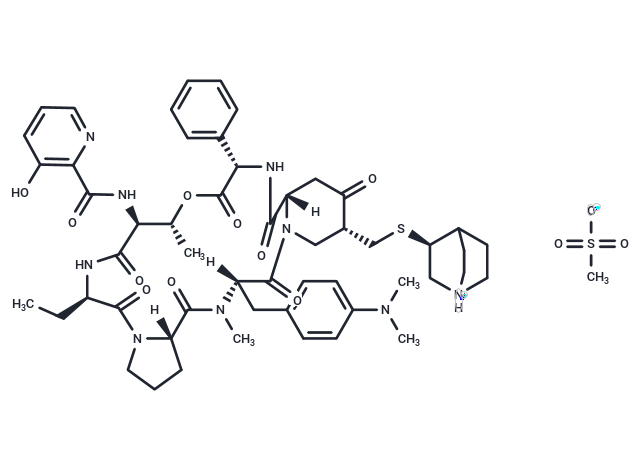keep away from moisture
Powder: -20°C for 3 years | In solvent: -80°C for 1 year

Quinupristin is a streptogramin antibiotic. Streptogramins, a class of antibiotics, is effective in the treatment of vancomycin-resistant Staphylococcus aureus and vancomycin-resistant Enterococcus, which are two of the most rapidly growing strains of multidrug-resistant bacteria. Streptogramins fall into two groups: streptogramin A and streptogramin B.

| Pack Size | Availability | Price/USD | Quantity |
|---|---|---|---|
| 5 mg | Inquiry | $ 1,116.00 |
| Description | Quinupristin is a streptogramin antibiotic. Streptogramins, a class of antibiotics, is effective in the treatment of vancomycin-resistant Staphylococcus aureus and vancomycin-resistant Enterococcus, which are two of the most rapidly growing strains of multidrug-resistant bacteria. Streptogramins fall into two groups: streptogramin A and streptogramin B. |
| In vitro | In vitro: Quinupristin can bind to sequential sites located on the 50s subunit of the bacterial ribosome. Dalfopristin binding causes a conformational change in the ribosome that subsequently increases the binding of quinupristin. The combined actions of the two agents create a stable drug-ribosome complex causing inhibition of protein synthesis by prevention of peptide-chain formation, blockade of extrusion of newly formed peptide chains, and bacterial cell death [1]. |
| In vivo | In vivo: The combination of quinupristin-dalfopristin (Q-D) and gentamicin was tested against two strains of gentamicin- and dalfopristin-susceptible methicillin-resistant Staphylococcus aureus (MRSA). A rabbit endocarditis model simulated the pharmacokinetics achieved in humans receiving intravenous injections of Q-D and gentamicin. For the MLSB-susceptible strain, a 4-day regimen reduced mean bacterial titers (MBT) in vegetations from 8.5 ± 0.8 logs CFU/g (control group) to 3.0 ± 0.9 (Q-D) and 2.6 ± 0.5 logs CFU/g (Q-D plus gentamicin). For the strain constitutively resistant to MLSB, a 4-day regimen reduced MBT in vegetations from 8.7 ± 0.9 logs CFU/g (control group) 5.2 ± 2.2 (Q-D) and 5.1 ± 2.4 log CFU/g (Q-D plus gentamicin). The differences between control and treatment groups were significant for both strains, although there was no significant difference between treatment groups [2]. |
| Synonyms | Quinupristin (mesylate) |
| Molecular Weight | 1118.3 |
| Formula | C53H68N9O10S·CH3SO3 |
| CAS No. | TP2286 |
keep away from moisture
Powder: -20°C for 3 years | In solvent: -80°C for 1 year
DMSO: Soluble
Ethanol: Soluble
You can also refer to dose conversion for different animals. More
bottom
Please see Inhibitor Handling Instructions for more frequently ask questions. Topics include: how to prepare stock solutions, how to store products, and cautions on cell-based assays & animal experiments, etc.
Quinupristin (mesylate) (120138-50-3 free base) TP2286 Others Quinupristin (mesylate) (120138503 free base) Quinupristin (mesylate) (120138 50 3 free base) 120138-50-3 Quinupristin (mesylate) 120138-50-3 free base Quinupristin inhibitor inhibit
